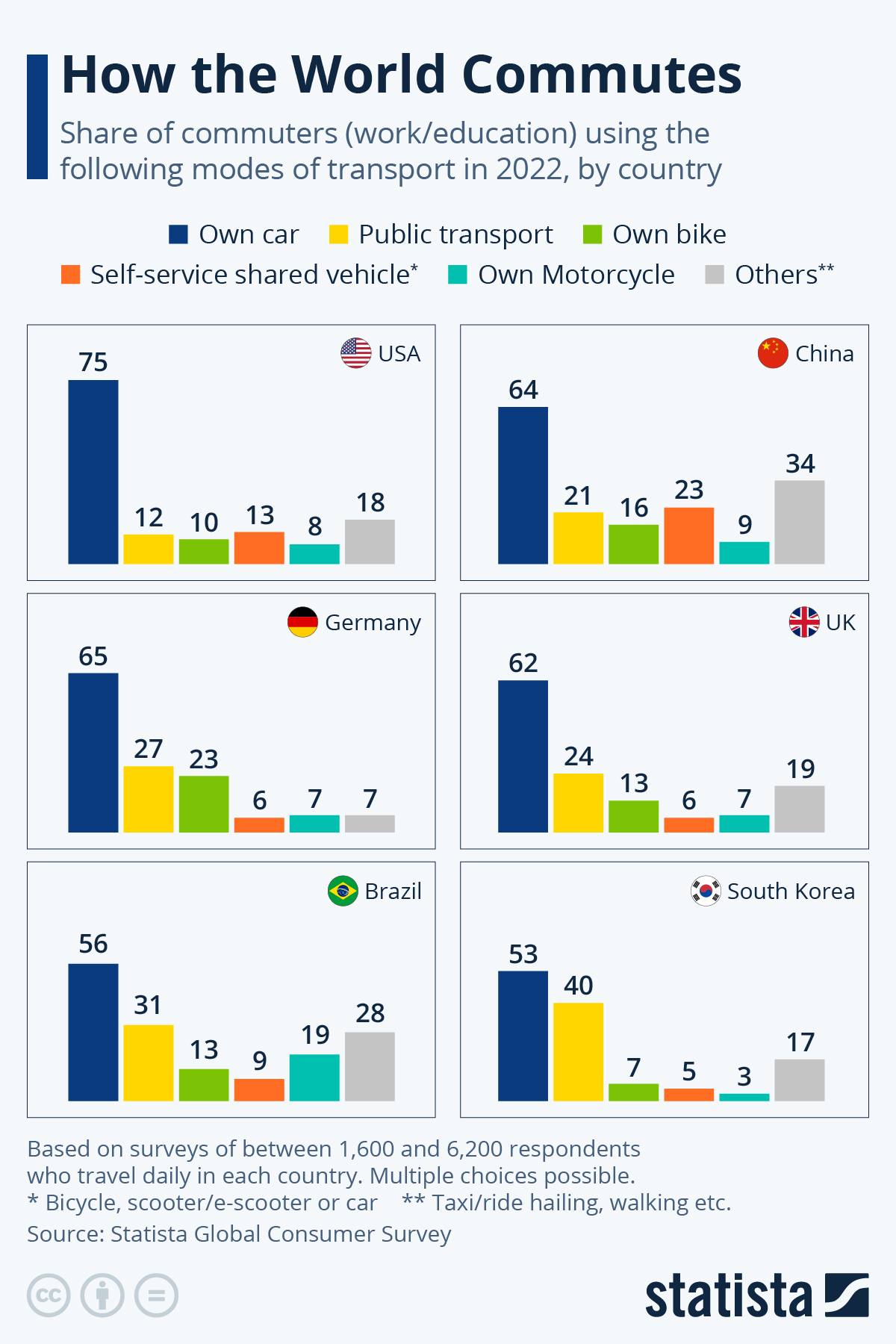Another demonstration of how NYC is the only real city in America and anywhere else is a suburb larping as a metropolis.
You can’t call yourself a metropolis unless half the population uses public transit: change my view.
Ok! As per the marriam-webster definition of a metropolis:
the chief or capital city of a country, state, or region,
the city or state of origin of a colony (as of ancient Greece),
a city regarded as a center of a specified activity,
a large important city.
As per Cambridge:
a very large city, often the most important city in a large area or country.
Collins:
A metropolis is the largest, busiest, and most important city in a country or region.
Britannica:
a very large or important city — usually singular
Oxford:
A very large urban settlement usually with accompanying suburbs. No precise parameters of size or population density have been established. The structural, functional, and hierarchical evolution of global metropolises is rooted as much in the past as in the present: modern information and communications technology may be more advanced than the 19th-century telegraph, but the processes and outcomes are much the same (Daniels (2002) PHG 26). ‘[Berlin’s] wealth of facilities, as well as their scatter across the metropolis, can be understood only in the light of the city’s history and, paradoxically, its troubles.
Longman:
a very large city that is the most important city in a country or area
You:
NYC but only if half the people use public transit
not OP, but according to some of those definitions (cambridge, collins, longman), NYC would be the only metropolis in the US, as it is the US’ largest, busiest, and most important city.
It goes by region. LA, San Diego, Chicago, Sacramento, San Francisco, Milwaukee, Detroit, Charlotte, Tulsa, San Antonio, Dallas, Atlanta, Cleveland, Las Vegas, Denver, etc… all fall under the definitions of a metropolis. And the most important city in US is not NYC, it’s Washington DC. NYC is just the most populated and industrialized, DC Trump’s it in significance because that’s the epicenter of trade, labor, and industry policies
Cries in Massachusettsan.
All those definitions use “city”. Does the definition of city require the kind of density that would make relying mostly on self-owned cars impossible? Depends, in america no, in other countries maybe.
Does the definition of city require the kind of density that would make relying mostly on self-owned cars impossible?
Ooooo, self-moving goalposts, nice!
Oooo passive aggressive people on lemmy, nice!
No it doesn’t. However original commenter put a challenge out on what a metropolis is. I responded to the challenge.
change my view.
Me and the Sullivan twins would like to have a conversation with you and a few baseball bats in the alley out back if you’re seriously arguing that Boston isn’t a metropolis… and don’t you dare fucking insult the Red Sox, Dunkin’ or the Bruins (actually, we care more if you bad mouth our college hockey teams) unless you’d like to qualify for Medicare early.
In Amsterdam the mode share for all trips is like 30% for biking and for walking and like 20% for driving and for transit
I was excited because I thought the bike path extension construction was going through, federal funding had been secured. I’d have been able to bike my kid over to daycare in a year. Well I guess the time to start building ran out and the funding expired. I don’t precisely know why, but I heard a council member was being petty. I’m so very disappointed In addition, that daycare closed down as well, so moot I guess
Are there similar maps available for other countries? Would be really intereseting to see

(source)
Not a map, but at least some more data from some other countries. The own car is unfortunately the most used mode of transport for commuting in every surveyed country, but the US seem to be especially far behind when it comes to alternatives.
They mixed taxi and ride sharing with walking in that statistic. For the purposes of car usage, it’s not really helpful. That’s still one car for one person, on the road for the amount of time that person is commuting (i.e. it doesn’t park, it goes and picks up another commuter)
Moreover, difference in land mass and population density matters when looking at this from a national perspective. United States has significantly more rural space than Germany. The map posted is kind of pointless because it’s only showing the most used form of transportation in each county, and that will always be cars with extreme outliers like New York City, no matter how much we invest in public transportation.
What they’re using is Bumblefunk County Oklahoma to get from their little town of 2,000 people to the factory 20 minutes away in some industrial park between Nowheresville and Chickentowm isn’t really relevant to the discussion. Public transportation is only really viable in dense areas, but everyone else in the country is going to still drive because they’ve got distance to cover or irregular routes. Even if we expanded rail across the country, people in those counties would still need to drive to the station.
I agree that both the map and the statistic I’ve posted don’t take those country-specific characteristics into account.
I’m not sure how important that difference really is, though, as both the US and Germany seem to have pretty similar degrees of urbanization (US: 83.3%; Germany: 77.8%; source). So the rural population isn’t really that big in either country, relatively speaking.
I’m not trying to say that the rural population isn’t a factor, I’m just not sure how big that factor really is.
The wording on that one makes me wonder. It says “own a car,” but I’m sure there are millions of people who own a car but don’t necessarily use it daily for work. Isn’t it fairly common in major cities to own a car and still take a train/bus to work because of traffic, using the car for things like weekend trips or errands? Idk if that’s enough to really swing of the stats, just that I wish they had phrased it differently.
It’s “own car”, as in, not a ride share or taxi cab. They get to work in their own cars.
Read it again ,including the title, it says own car, not own a car, which means that they use it to commute. That said, it’s worded a bit poorly
It says “own car”, not " own a car" (?)
It doesn’t say “own a car”, it says “own car”. As in, “How do you get to work?” “By my own car.”
I think this map would really benefit if the colors would be slightly adapted to show the percentage. In some regions, 50% commute by car, in other regions maybe 90% - and both are green.
It really highlights the fact that most of us (also in europe) depend on our cars to make a living.
Outside the US there are very few major cities that don’t depend on public transport, because it is the most efficient way to move millions of people around a city. Ultimately it depends on the quality of public transport.
Why is “motorcycle” in a different category than “Drive Alone”?
Climate impact is significantly less for motorcycle riders, that’s the only mitigation I can think of.
Motorcycles are one of the worst forms of transportation.
1 rider, 1 engine often regulated well below what automotive emissions standards require.
My understanding is that motorcycles (especially modern motorcycles) produce significantly less CO2 equiv than modern cars - in no small part due to their ability to not get caught in traffic.
Most commuters are 1 person per vehicle.
CO2 is only a small part of the story
the motorcycle used 28% less fuel than the comparable decade car and emitted 30% fewer carbon dioxide emissions, but it emitted 416% more hydrocarbons, 3,220% more oxides of nitrogen and 8,065% more carbon monoxide.
So yeah. Not exactly great. And btw our option on those hydrocarbons have changed a LOT in the last 13 years when this was published. See the decline of diesels post dieselgate.
That’s just not true though.
Motorcycles do not have to meet the same stringent requirements as cars because they aren’t classified as cars.
This holds true in most “western” nations.
They’re allowed higher emissions and put out more emissions per person than cars do.
You guys can downvote me all you want but 1 person in 1 car emits less emissions than 1 person on 1 motorcycle.
This is NOT an argument for cars but an argument AGAINST a single user motorized transport.
This doesn’t negate the argument against cars but it’s strange to see people arguing FOR another form of motorized transport rather than walkable cities OR mass public transportation.
1 person in 1 car emits less emissions than 1 person on 1 motorcycle.
[citation needed]
Outlandish claims are fine, but you need to either substantiate them or stop complaining that people don’t believe your obviously-false bullshit.
Can you link those findings? I find this hard to believe since cars are so much heavier than motorcycles. Maybe a full van, is better emissions per capita? But with a single user for a car I am skeptical but open to being shown to be wrong

You do know that almost all modern on-road motorcycles are CARB-compliant, right? Oh, but what about those small motorcycles? https://www.transportpolicy.net/standard/us-motorcycles-emissions/ As of 2006, all Class I and II motorcycles must be compliant with few exceptions.
I don’t know where you are getting your numbers for your claims. These are some significant assertions that, even prima facie, don’t make sense.
1 person in 1 car emits less emissions than 1 person on 1 motorcycle
Even from just a thermodynamics standpoint, this assertion not only feels wrong, but is wrong. Maybe a two-stroke motorcycle could out-emit a modern SOV.
One, they are much better on gas use. So less energy in general to move them.
Two, they are much lighter, which as we are discovering with electric vehicles, matters a great deal in how horrible the tire wear is (and remember that 28% of microplastics in the environment come from car tire degradation alone!).
Three, for traffic purposes, they are much, much better. They are smaller, so recall that picture that floats around of how much space 100 passengers takes up. They aren’t near the train/bus level, but are closer to the bicycle portion of the picture than the cars. It becomes even better if they are scooters compared to motorcycles (scooters are generally even lighter and have smaller engines with better gas usage). I always hear the stat thrown around that if 25% of individuals switched to motorcycles, modern traffic jams in cities (in America, I guess, where I hear it uttered) would nearly disappear.
They pollute more and use more energy to move a single person.
Motorcycles are worse than cars…
How exactly does a motorcycle that gets 60 mpg (3.92 l/km) take more energy to move a single person that a car that gets 25 mpg (9.4 l/km)? Notice that almost nobody carpools in America, which is the subject of this post.
Also note that almost all motorcycles sold worldwide comply with Euro 5 emissions standards.
Emissions systems. Do you realize just how toxic something without a catalytic converter is? Let alone one that doesn’t work for shit like the types installed on bikes.
Also a car is probably FAR more efficient at burning fuel than a bike. The efficient burn lets out even less toxic gasses despite using 3x the fuel.
Take the totally emissions free lawn mower market and scale down emissions a bit since bikes do have some emissions equipment and electronic fuel injection. But they really don’t have much, and they’re very often just removed/bypassed.
https://psci.princeton.edu/tips/2020/5/11/law-maintenance-and-climate-change
Motorcycles use 50% less fuel than cars. And at least for the daily commute, both carry the same amount of people (one). Additionally, they need about 1/4 of parking space.
I’m guessing those red areas in Alaska are literally only because there are no roads.
That, or those people live in the place they work, or else only a few minutes away.
I think you nailed it. The majority of the northern portion of alaska is going to be oil/gas workers, lumberjacks, and perhaps researchers and native tribes. All of those probably have company barracks, cabins, or if there is a ‘town’ it’s going to be a few hundred yards wide. For the towns, it’s due to the winter, when you almost need to be close to other people in case something goes wrong, because significant help is a long way away in distance and time.
Or people
And the blue area is definitely “commute by boat”, btw.
I assume carpooling would be blue? I’m surprised that is hidden under “other means”
What about Mackinac Island?
Reform alone will not be enough. It needs a new revolution.





